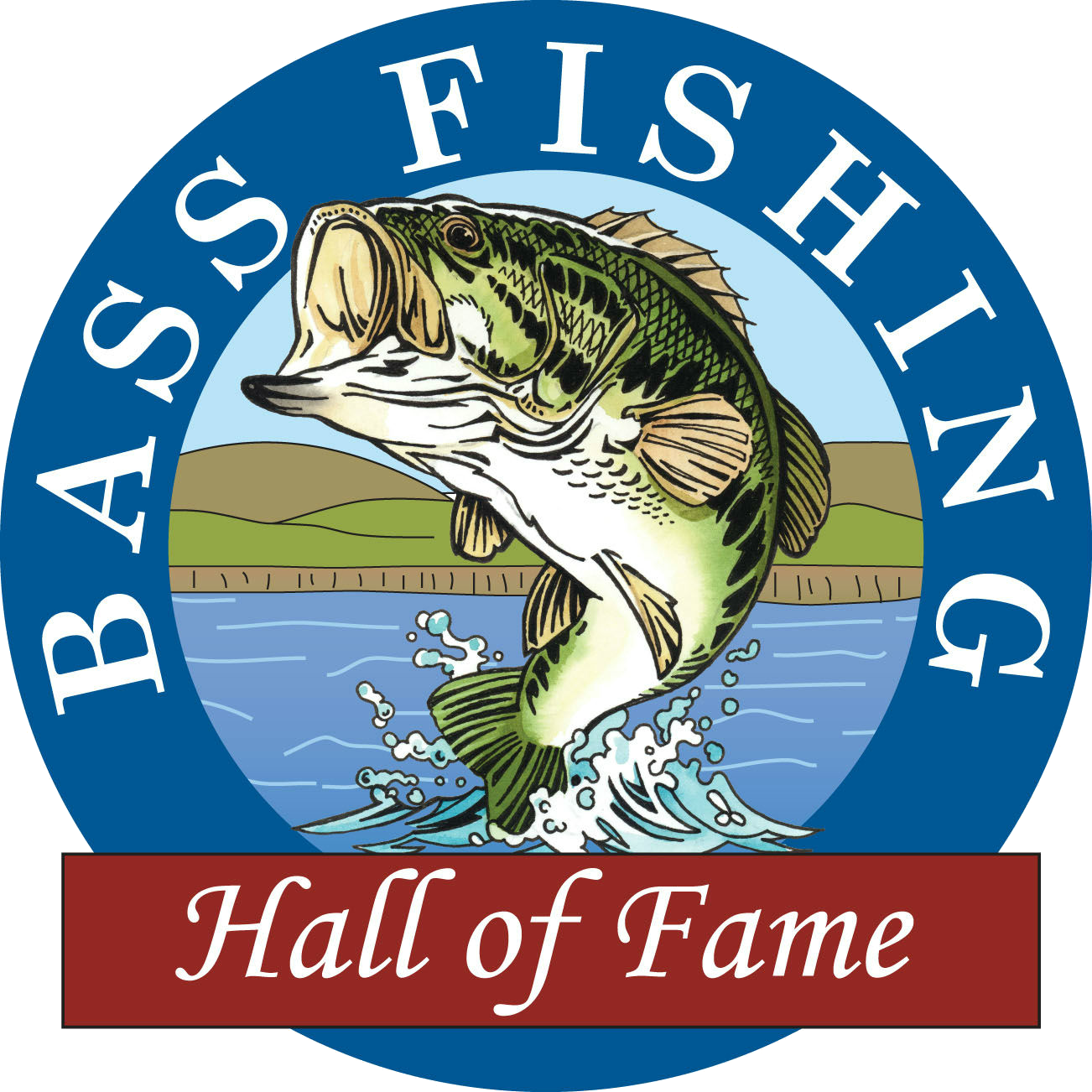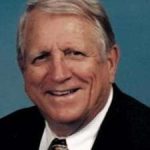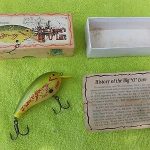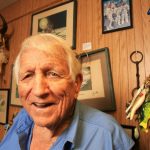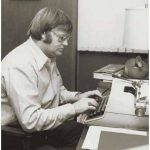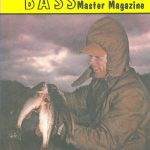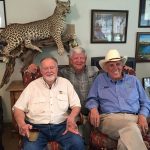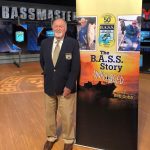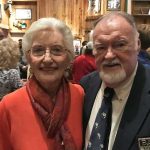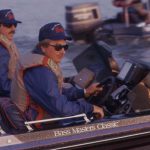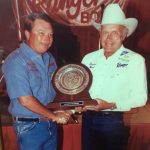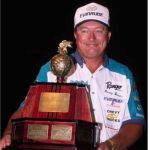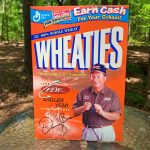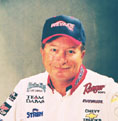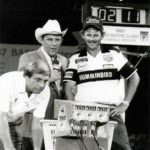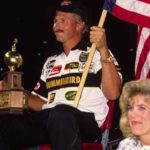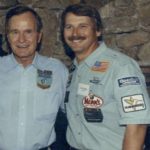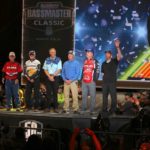Cotton Cordell
Cotton Cordell (1928—2015) When Cotton Cordell was just a kid, his father owned a boat landing on Lake Catherine, in Hot Springs, where he cut his teeth on fishing, guiding, and lure designing.
After World War II, he discovered that, by purchasing survival kits that had been stowed on military aircraft, he would get a knife, a razor, twine, bandages, and a bucktail jig, made with white-tail deer hair. It was the jig that caught his attention.
When war survival kits became scarce, he learned to improvise by using hair from his English Setter. “Dog hair will catch just as many fish as deer hair. But before it was over, I had the baldest English Setter in the world”. Quite an inauspicious beginning for sure and one that led Cordell to form his own lure company when the demand for his jigs outgrew his ability to make them in the bathroom of his small bait and tackle shop.
By the time he sold Cordell lures in 1980, he had designed or obtained marketing rights to lures that are still produced by the millions and have become household names. He bought the rights to make and sell a plastic version of Fred Young’s wooden “Big O” crankbait and helped launch the “alphabet crankbait craze.”
Once a fishing lure designer, always a fishing lure designer. His office was literally carpeted with dozens of wood carvings of prototype lures and hand-shaved plastic molds that he knew one day would help everyone catch more fish.
Cordell was elected into the National Freshwater Fishing Hall of Fame in 1987, and into the Arkansas Outdoor Hall of Fame a few years later. He was a past Board of Directors Member of the Ouachita Baptist University and an Honorary Member of the National Fishing Lure Collectors Club.
Cotton Cordell
Bob Cobb — While Ray Scott gets much-deserved credit as the father of modern bass fishing, the keenest observers of those early years of Scott’s B.A.S.S. organization agree that the movement probably would not have survived without the relentless efforts and creative genius of Bob Cobb.
Cobb, the outdoor editor of the Tulsa Tribune in 1967, when Scott was organizing his first professional bass tournament at Beaver Lake, Arkansas, not only covered the first media event, but he also used his newspaper column to help recruit enough anglers to make the tournament a success. Without that boost, Scott acknowledges, the All-American Bass Tournament would have been dead in the water.
After editing and publishing the first few issues of the membership magazine, Bassmaster, Scott knew he needed a professional to steer the publication. Bob Cobb was the obvious choice. Most periodicals of that day used outdoor writers as the experts in how-to stories and armchair adventures. Cobb turned that model on its head. Instead, he milked the minds of tournament anglers to create cutting-edge content about bass fishing.
“A bass tournament was like a laboratory,” Cobb often said. “There was a big funnel, and everybody who came in with fish poured some knowledge into the funnel, and out dripped how-to information that went straight onto the pages of Bassmaster.”
“Bob was not publishing pretty stories about how beautiful the sun was at daybreak,” said Harold Sharp, the first B.A.S.S. tournament director. “He was telling it like it is, and he knew when a story was real or not because he was a good bass angler himself.”
The formula worked, and immediately, membership in the Bass Anglers Sportsman Society grew past 9,000 and Ray Scott’s dream was becoming a reality.
Cobb was instrumental in the success of numerous other initiatives that helped gain momentum for B.A.S.S. He and Scott conceived the Bassmaster Classic, which would mushroom into the “Super Bowl of Bass Fishing” and the most important event in sportfishing.
He steadily won over outdoor journalists who were opposed to competitive fishing, in large part by inviting them to fish alongside the Classic contenders as “press anglers” and observers. When B.A.S.S. created the Bassmaster Seminar Circuit, which featured top pros like Roland Martin and John Powell sharing their fish-catching secrets, Cobb’s knack for creating advance publicity ensured packed houses in auditoriums in major cities across the country.
B.A.S.S. also made a name for itself by taking on industrial polluters that were discharging poorly treated wastewater into rivers and lakes. After the organization filed a round of lawsuits under the 1899 Federal Refuse Act, Cobb’s public relations campaign brought America’s water quality crisis to the attention of the non-fishing public and garnered coverage on national television news programs.
“He created enough press that finally the government formed the EPA (Environmental Protection Agency) to try to put a stop to this problem,” recalled Sharp. The crusade solidified B.A.S.S. as a conservation-oriented organization dedicated to improving aquatic resources across the country.
Through his dual roles as editor of Bassmaster and publicity director for B.A.S.S., Cobb made household names out of some of the leading anglers of the day. Bill Dance, Tom Mann, Bobby Murray, along with Martin, Powell and many others were able to line up sponsors and parlay their fishing abilities into lucrative careers, thanks in large part to the promotion Cobb gave them.
Between 1969 and 1984, Cobb edited more than 150 issues of Bassmaster — some swelling to more than 200 pages — as well as numerous how-to books and special magazine issues. His magazine so dominated the world of fishing journalism that Time Magazine labeled Bassmaster “the Bible of Bass Fishing.”
After 16 years at the helm of Bassmaster, Cobb launched a second career, this time in television. Again, he was a pioneer in his chosen field.
With a background of producing annual “movies” built around the Bassmaster Classics, Cobb took over as creator, producer, director, writer and sometime host of “The Bassmasters” TV show, which debuted in 1984 on TNN — The Nashville Network. It was the first television series built around competitive bass fishing, and it was an almost instant hit.
As the highest-rated program on TNN, “The Bassmasters” further drove attention to the sport of professional bass fishing, increased membership in B.A.S.S. and lured major national sponsors and advertisers in the automotive, petroleum and insurance industries to the sport.
Now living in Atlanta, Cobb continues to be active in the bass fishing community, appearing at major B.A.S.S. events and promoting his 412-page opus, The B.A.S.S. Story — Unplugged. The richly illustrated coffee-table book chronicles the birth of modern bass fishing and solidifies Cobb’s remarkable role in the movement.
- The Bassmaster Magazine debuted with the Spring 1968 issue
- Sevier with Bob Cobb at the 208 HOF Induction Banquet
Bob Cobb
DENNY BRAUER (1949—) – Nebraska native Denny Brauer left a career as a brick mason to uproot his family to Missouri to chase his dream of becoming a professional angler, and went on to become the most notable flipper and pitcher in bass fishing history. Building on the legacy of innovators like 2007 inductee Dee Thomas, Brauer went on to reach the pinnacle of the sport, earning not just Bassmaster and FLW Angler of the Year titles but also the 1998 Bassmaster Classic trophy.
After being introduced to a copy of Bassmaster Magazine by a co-worker, Brauer started competing with the Blue Valley Bass Club of Seward Nebraska, and worked himself up through the ranks of the B.A.S.S. Nation. Two years after he competed in the 1978 B.A.S.S. Nation Championship in Alabama, the professional circuit visited his adopted home waters, the Lake of the Ozarks, and he decided to enter. The resulting 20th place finish and $1,000 check were the gateway to a career that spanned the better four decades and left an indelible impression on the rise of one of the sport’s most deadly techniques.
Lake of the Ozarks played a crucial role in his success. The lake was extremely fertile in the 1980s and offered a wide variety of cover and structure, but its countless boat docks were of particular note – they led him to become a proficient and devoted jig flipper, which became his calling card. He guided both there and on the newly-impounded Truman Reservoir and built up an encyclopedia of techniques and trips through his hours on the water.
Brauer went on to win 17 B.A.S.S. tournaments, the first in 1984 and the last in 2011, on the way to accumulating over $2.5 million dollars in earnings from that circuit. Those victories included not just regular season events, but also the 1987 Super Invitational on Kentucky Lake, the 1992 Megabucks on Guntersville, the 1993 SuperStars on the Illinois River, and of course the 1998 Bassmaster Classic on High Rock Lake. He competed in a total of 21 Classics, and finished in the top 10 in eight of them. During his Classic victory he factored in the knowledge that spectator traffic might hinder his shallow water flipping pattern and specifically sought out areas where boat traffic and boat wakes would not impact his targets.
In addition to B.A.S.S. events, Brauer also fished all or part of seven FLW Tour seasons, qualifying for five Forrest Wood Cups, and adding another quarter of a million dollars to his career earnings. The same year that he won the Classic he also won the FLW Tour Angler of the Year award, and became the first angler to be featured on the Wheaties cereal box, joining other champions including Michael Jordan and Tiger Woods.
Long after his time on the FLW Tour ended in 2003, he continued to compete in FLW Outdoors events, mostly in Texas, and in 2014 he won a Toyota Series tournament on Toledo Bend, beating a best-of-the-best field of local and national talent.
His success made him a polished and highly-desirable seminar speaker, and also led to two appearances on the The David Letterman Show. On the first one, he was there with Ozzy Osbourne and proceeded to give the rock and roll legend an impromptu casting lessons on a New York City street. He was also the host of a popular show called The Bass Class on ESPN2.
Over the course of his lengthy career, Brauer developed numerous long-term sponsor relationships, most notably with Ranger Boats and Strike King Lure Company, and his name was affixed to countless “signature” products. His Bassmaster Classic victory was instrumental in introducing the flipping tube to a wide audience – before that it had been a closely-guarded secret of a handful of pros.
He also raised a fellow B.A.S.S. champion. His son Chad qualified for three Bassmaster Classics and won a 1996 Bassmaster Top 100 on Old Hickory Lake and a 2010 Bassmaster Central Open on the Red River.
Denny Brauer was inducted into the Bass Fishing Hall of Fame in 2002.
Denny Brauer
Hank Parker — After many successful years guiding and fishing tournaments around the Carolinas, Hank Parker launched his professional tournament fishing career in 1976, when he began fishing the National Bass Association Tournament Circuit, winning that tour’s national championship in his first season. After competing on the NBA and American Bass Association tours in 1977, he parlayed his growing notoriety into sponsorships that enabled him to join the Bass Anglers Sportsman Society circuit in 1978.
During the course of the next 13 years, he competed in over 100 B.A.S.S. tournaments and finished in the money an astonishing 77 percent of the time.
A force in bass fishing from the beginning, he achieved stardom by winning the 1979 Bassmaster Classic at Lake Texoma, Texas, in only his second year on the tour. He qualified for the prestigious world championship every season he competed, from 1978 through 1990 — an amazing 13 in a row. He became one of the very few individuals to earn more than one Classic title when he won in 1989 on the James River out of Richmond, Virginia, claiming the crown by a 2-ounce margin over Jim Bitter of Florida. It was one of the narrowest winning margins ever.
He finished in the Top 10 in six Classics, never ending up lower than 19th. He won a total of five B.A.S.S. events in those years, including the 1983 Virginia Invitational on the James River, the 1985 Super B.A.S.S. tournament on the St. Johns River, Florida, and the 1988 Missouri Invitational on Truman Reservoir. He also had 32 Top 10s in his career.
Parker was the first angler to win the “Grand Slam” of competitive bass fishing titles, including the Classic, Super B.A.S.S., a regular season tournament, and the Bassmaster Angler of the Year title in 1983.
Bryant Gumbel, when he was host of the CBS Morning Show, described Parker as “the rod-and-reel answer to Michael Jordan, in popularity and talent.”
Despite all those achievements in competitive fishing, Parker is perhaps better known for the career he built as a TV fishing show host after leaving the B.A.S.S. Tour. His long-running “Hank Parker’s Outdoor Magazine” show, which aired on The Nashville Network, ESPN and other networks over the following decades. He lent his name and likeness to a fishing video game on the Super NES platform, “Black Bass with Hank Parker,” released in 1984.
Known for his integrity and loyalty, he continued through decades of competitive fishing and television programming with most of the same sponsors, including Ranger Boats and Mercury Marine.
In addition to his tournament titles, Parker has been inducted into the Bass Fishing Hall of Fame (in 2003), the International Game Fish Association Hall of Fame and the Legends of the Outdoors Hall of Fame.
Even though he fished his first regional bass tournament more than 50 years ago, at only 16 years of age, Parker — like most hall of famers — has never grown weary of fishing. “Whether it’s largemouth, smallmouth, muskie, redfish, any fish . . . I never get tired of fishing,” he said.
Hank Parker
When Tommy Martin first began tournament fishing in 1968, little could he have known that it would lead him into a thirty-five year career. A career that has seen him go from guiding on Lake Sam Rayburn, Texas, in the late 60’s, to guiding on Lake Livingston, Texas, in 1969. From there, he moved on to fishing the Bass Anglers Sportsman Society’s tournament trail in 1972. Since then, he has won 19 national tournament titles, with over one million dollars in prize money. He has qualified for the prestigious BassMasters Classic 19-times and captured five different B.A.S.S. tournament championships: the ’74 Classic; the 1974 Arkansas Invitational; the 1981 Texas invitational; the 1983 Texas Invitational and the 1995 Oklahoma Invitational.
Along with winning the 1974 BassMasters Classic, he became the first professional angler, in B.A.S.S. tournament history, to win both a B.A.S.S. Classic and a regular season tournament, during the same season, when he captured the Arkansas Invitational on Beaver Lake. A feat that has rarely been accomplished since.
He has won tournaments in three different decades. Something that only a couple of other anglers in professional bass fishing have ever accomplished. Today, even though he is in his early sixties, he continues competing successfully along the Citgo BassMaster tour. Tommy Martin has competed in over 280 B.A.S.S. tournaments since he first started fishing them and has taken home a check in more than half of these events.
Tommy Martin
It’s one thing to win bass tournaments, which Tom Mannhas done, but it’s an entirely different matter to design, produce and manufacture fishing lures for the professionals and weekend anglers to use. When he began his lure manufacturing business, in 1958 with $5.00, on his kitchen table, I doubt that anyone, especially himself, thought that it would one day grow into one of the most widely recognized lure companies in the world. While he held down a full-time job, as an Alabama Game warden, his love of catching fish, designing lures and, with the help of a supportive wife, proved to be a winning combination. It didn’t hurt that he moved his business to the tiny town of Eufaula, Alabama, and located his manufacturing plant on the shores of one of the best big bass lakes in the country.
When Lake Eufaula came to the nation’s attention, in the late 60’s and early 70’s, Tom Mann was ready to supply them with the needed lures to land one of those “Alabama lunkers”. His famous “Little George” tail spinner, “Deep Pig” crankbait, “Wooly Bully” spinnerbaits and scented “Jelly Worms” became mainstays in every angler’s tackle box, from California to Connecticut. His world famous “Jelly Worms” were distinguished by being named after different fruits. Who, in the 60’s, 70’s and 80’s didn’t get a funny look from their wife when they told them that they were going fishing with blueberry or watermelon or strawberry worms? Each color in the Mann’s “Jelly Worm” collection was named after a different fruit and had a scent that smelled like that fruit. It wasn’t Tom who named the flavors of the “Jelly Worm” collection, it was his wife, Ann. A supporter for more than fifty years!
Not content with just manufacturing fishing lures, while the owner of Mann’s Bait Company, he also founded and was the C.E.O. of Allied Sports Company, from 1969-1983. As the manufacturer of the “Humminbird Depth Sounder”, Allied Sports eventually became a stock company and was renamed Techsonic Industries: one of the largest selling depth sounder companies in the world. He also founded Southern Plastics, in 1977, a company that today is the world’s largest private brand supplier of soft plastic lures.
Designing and building baits to catch fish, and creating companies that would help every angler on the water, were just a part of his repertoire. He knew how to catch ’em as well, as his success along the Bass Anglers Sportsmans Society tournament trail quickly proved. He began his professional tournament career along the B.A.S.S. tournament trail in 1967 by competing in the Dixie Invitational. In 1971 he captured his first national title by winning the B.A.S.S. Georgia Invitational on Lake Seminole, Georgia. He then followed that impressive victory with another championship performance by winning the 1972 B.A.S.S. Florida National, on Lake Kissimmee, Florida. In all, Tom Mann fished in 104 Bass Angler Sportsman Society tournaments, taking home over $36,000.00. When compared to today’s dollars, that would have been in excess of $700,000. He also qualified for 7 BassMasters Classics and has the distinction of finishing in second place in the very first BassMasters Classic, on Lake Mead, Nevada, behind fellow hall of fame member, Bobby Murray.
He has been inducted into the Freshwater Fishing Hall of Fame, and he received the Fishing Hall of Fame’s highest honor, the Dolphin Award. He has been named as one of Alabama’s most unforgettable faces, by the Alabama Bureau of Tourism and Travel and has authored two of the all time best selling books on bass fishing. Tom Mann is still active in designing fishing lures and also co-hosts a nationally syndicated television program called, “Tom and Tina Outdoors” with his co-host, Tina Booker.
